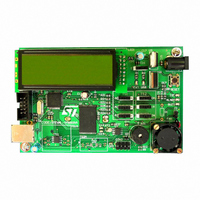STEVAL-IFS003V1 STMicroelectronics, STEVAL-IFS003V1 Datasheet - Page 133

STEVAL-IFS003V1
Manufacturer Part Number
STEVAL-IFS003V1
Description
BOARD STLM75/STDS75/ST72F651
Manufacturer
STMicroelectronics
Datasheets
1.STLM75DS2F.pdf
(40 pages)
2.STDS75M2F.pdf
(39 pages)
3.STEVAL-IFS003V1.pdf
(161 pages)
4.STEVAL-IFS003V1.pdf
(4 pages)
Specifications of STEVAL-IFS003V1
Design Resources
STEVAL-IFS003V1 Gerber Files STEVAL-IFS003V1 Schematic STEVAL-IFS003V1 Bill of Materials
Sensor Type
Temperature
Sensing Range
-55°C ~ 125°C
Interface
I²C
Voltage - Supply
7.5 V ~ 19 V
Embedded
Yes, MCU, 8-Bit
Utilized Ic / Part
ST72F651, STDS75, STLM75
Silicon Manufacturer
ST Micro
Silicon Core Number
STLM75/STDS75 And ST72F651AR6
Kit Application Type
Sensing - Temperature
Application Sub Type
Temperature Sensor
Kit Contents
Board
Lead Free Status / RoHS Status
Lead free / RoHS Compliant
Sensitivity
-
Lead Free Status / Rohs Status
Lead free / RoHS Compliant
Other names
497-6238
13.7 EMC CHARACTERISTICS
Susceptibility tests are performed on a sample ba-
sis during product characterization.
13.7.1 Functional EMS (Electro Magnetic
Susceptibility)
Based on a simple running application on the
product (toggling 2 LEDs through I/O ports), the
product is stressed by two electro magnetic events
until a failure occurs (indicated by the LEDs).
■
■
A device reset allows normal operations to be re-
sumed. The test results are given in the table be-
low based on the EMS levels and classes defined
in application note AN1709.
13.7.1.1 Designing hardened software to avoid
noise problems
EMC characterization and optimization are per-
formed at component level with a typical applica-
13.7.2 Electro Magnetic Interference (EMI)
Based on a simple application running on the
product (toggling 2 LEDs through the I/O ports),
the product is monitored in terms of emission. This
emission test is in line with the norm SAE J 1752/
3 which specifies the board and the loading of
each pin.
Notes:
1. Data based on characterization results, not tested in production.
Symbol
Symbol
ESD: Electro-Static Discharge (positive and
negative) is applied on all pins of the device until
a functional disturbance occurs. This test
conforms with the IEC 1000-4-2 standard.
FTB: A Burst of Fast Transient voltage (positive
and negative) is applied to V
a 100pF capacitor, until a functional disturbance
occurs. This test conforms with the IEC 1000-4-
4 standard.
V
V
S
FESD
FFTB
EMI
Voltage limits to be applied on any I/O pin to induce a
functional disturbance
Fast transient voltage burst limits to be applied
through 100pF on V
tional disturbance
Peak level
Parameter
DD
Parameter
DD
and V
and V
V
LQFP64,
conforming to SAE J 1752/3
DD
DD
pins to induce a func-
SS
=5V, T
through
Doc ID 7215 Rev 4
Conditions
A
=+25°C,
tion environment and simplified MCU software. It
should be noted that good EMC performance is
highly dependent on the user application and the
software in particular.
Therefore it is recommended that the user applies
EMC software optimization and prequalification
tests in relation with the EMC level requested for
his application.
Software recommendations:
The software flowchart must include the manage-
ment of runaway conditions such as:
– Corrupted program counter
– Unexpected reset
– Critical Data corruption (control registers...)
Prequalification trials:
Most of the common failures (unexpected reset
and program counter corruption) can be repro-
duced by manually forcing a low state on the RE-
SET pin or the Oscillator pins for 1 second.
To complete these trials, ESD stress can be ap-
plied directly on the device, over the range of
specification values. When unexpected behaviour
is detected, the software can be hardened to pre-
vent unrecoverable errors occurring (see applica-
tion note AN1015).
V
conforms to IEC 1000-4-2
V
conforms to IEC 1000-4-4
DD
DD
=5V, T
=5V, T
0.1MHz to 30MHz
30MHz to 130MHz
130MHz to 1GHz
SAE EMI Level
Frequency Band
A
A
Monitored
=+25°C, f
=+25°C, f
Conditions
OSC
OSC
=12MHz
=12MHz
[f
12/6MHz
OSC
Max vs.
ST72651AR6
22
27
34
4
/f
CPU
]
133/161
Level/
dBμV
Class
Unit
3B
4A
-




















